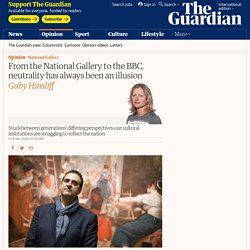

Elizabeth Anionwu: the ‘cool, black and exceptional’ woman who fought to make the NHS fairer. When Elizabeth Nneka Anionwu was a child, she had severe eczema – bad enough to need daily dressings and slatherings of coal tar paste.

Brought up in care until she was nine by nuns at the Nazareth House convent in Birmingham, she remembers this as torture. “None of the nuns were deliberately trying to hurt me, but they would tear the bandaging off and my skin would come with it,” she says. The exception was when a nun dressed in white, rather than the usual black habit, turned up to look after her. “She would tell rude jokes and use bad words like ‘bottom’ as a form of distraction therapy,” says Anionwu. “I adored her.” It was a career that brought her unimaginable success, as Britain’s first sickle cell and thalassemia nurse specialist.
First, however, she had to overcome an upbringing marred by racism and physical abuse. Shareholders can't force businesses to act morally. But governments can. Mark Carney stuck it to laissez-faire capitalists in his Reith lecture last week.

There has always been a moral dimension to selling stuff, the former Bank of England governor told any listening free marketers. Their own bible would tell them so. The bible in question was written by Adam Smith, the 18th-century Scottish moral philosopher and economist whose phrase “the invisible hand” is trotted out by every pro-market evangelist keen to justify the idea that governments should let businesses get on with selling, unfettered except by the most basic regulations. Gladys West: the hidden figure who helped invent GPS. Gladys West knew from a young age that she didn’t want to be a farmer.

The Guardian view on Ethiopia: a tragedy in the making? What a difference a year makes.

Just over 12 months ago, Abiy Ahmed won the Nobel peace prize. The Ethiopian prime minister had overseen extraordinary change in his brief tenure: though the committee singled out the peace deal he had signed with Eritrea, ending an apparently intractable dispute, he had also embarked upon sweeping domestic reforms. Yet while the relaxation of intense political repression brought real hope, there was also fear that the improvements were precarious at best, with too much expected of one man. Now Africa’s second most populous nation is on the brink of civil war. Historian finds clues to grave of Britain’s first black army officer. A historian believes he may have uncovered clues about where Britain’s first black army officer was laid to rest.

Walter Tull served in the first world war as a second lieutenant, leading men into battle at a time when the army forbade a person of non-European descent becoming an officer. From the National Gallery to the BBC, neutrality has always been an illusion. The board meeting seems to have begun, as it does at grand British institutions, in reliably stuffy fashion.

What can we learn about 2020 from the Black Death? Dorsey Armstrong has all the answers. A pandemic rages across the globe, leaving a trail of death, confusion and economic ruin, and changing everything.

This is a new disease, about which little is understood. People and communities don’t know what to do, and they react in different ways – sensibly, understandably, honourably, idiotically, criminally. Cities go into lockdown, quarantine rules are introduced, new hospitals are built to try to cope with the numbers of sick. Turner’s Modern World review – a roaring, wondrous whirlpool of a show. It’s not standard practice for curators to draw attention to a masterpiece they failed to borrow.

But right in the middle of Tate Britain’s roaring whirlpool of a Turner exhibition is a reproduction of his 1840 painting Slave Ship (Slavers Throwing Overboard the Dead and Dying, Typhoon Coming On). Apparently, it has become too frail to make the transatlantic journey from Boston’s Museum of Fine Arts – another twist in the story of the most devastating work of art ever made about the British slave trade. So, instead of passing over its no-show, the exhibition demands you pause to mourn it – and what it depicts. This painting belongs at the heart of Turner’s Modern World even though it’s just here as an idea, a concept, with an excerpt from David Dabydeen’s poem Turner next to the repro. That’s because this exhibition presents Turner as a passionate and engaged painter of modern life. Why was Turner able to visualise this horror? Time's Monster by Priya Satia review – living in the past. In his celebrated “Letter from Birmingham jail”, written in 1963 while in prison for having taken part in a banned march against segregation, Martin Luther King Jr describes receiving a letter from a “white brother in Texas” who had told him that “all Christians know that the coloured people will receive equal rights eventually, but it is possible that you are in too great a religious hurry”.

“Such an attitude”, King wrote, “stems from a tragic misconception of time”, from “the strangely irrational notion that there is something in the very flow of time that will inevitably cure all ills”. I was reminded of that line as I read Priya Satia’s Time’s Monster. For it’s the same “irrational notion” about “the flow of time” against which Satia, professor of international history at Stanford University, argues. Time’s Monster is a book about history and empire. Liberal imperialism was inherently contradictory, both demanding and denying freedoms and liberties. Historic England: heritage sites at risk – in pictures. The UK government is trying to draw museums into a fake culture war. At the bottom of Oxford’s Cowley Road you won’t find a bronze statue of a colonial-era British soldier, in campaign dress and pith helmet, rifle raised to the ready position, that commemorates the Boer war.

Nor will you find human skulls arranged by type for the purposes of so-called “race science” in Oxford University’s Museum of Natural History. That 1903 memorial to the Oxfordshire Light Infantryman was removed, with no nostalgic or jingoistic fuss, back in the 1950s. It now stands 10 miles away at Edward Brooks barracks, Abingdon. And those skulls were removed from anthropometric displays in 1946, as anthropology started the ongoing task of dismantling its racist infrastructure after the victory over fascism. The ongoing evolution of our historic built environment and museum displays, keeping in step with wider social change without heavy-handed governmental interference, is normal.
Until now. Let us be clear. Enslaved review – Samuel L Jackson presents a brutally poignant history of the slave trade. This year has seen a proliferation of freshly commissioned shows examining racism in response to the Black Lives Matter movement. Enslaved (BBC Two, Sunday), however, predates the death of George Floyd, and would surely have been prominently screened regardless of this year’s events. After all, it has a bona-fide superstar presenter in Samuel L Jackson, alongside Afua Hirsch of the Guardian and investigative journalist Simcha Jacobovici.
Clearly aware that there have already been numerous slavery documentaries, this four-part series seeks to tell a different story by uncovering new evidence. Wreck of the world’s oldest slave ship at risk of destruction. A 17th-century English shipwreck, the world’s earliest vessel linked to the transatlantic slave trade, is facing complete destruction by 21st-century fishing trawlers.
The 1680s Royal African Company trader – seen as a burial ground of slaves who perished on its final voyage – lies on the seabed about 40 miles south of Land’s End. It is being “pounded into oblivion” by “bulldozers of the deep”, claimed a leading British marine archaeologist. This was a trade that saw more than 12 million Africans taken across the Atlantic in 45,000 voyages over 400 years.
Many did not survive the journey. Any submerged evidence offering insights into untold horrors that the slaves had endured on board such ships will be lost for ever, warned Dr Sean Kingsley. He said: “Fifty years ago, this wreck must have been a thing of wonder. “Wrecks should be used as museums for memory and education. Revealed: Soviet spies targeted George Orwell during Spanish civil war.
They had a common enemy in General Franco’s fascist-backed army, but that did not stop legions of communists, revolutionaries and anarchists in 1930s Spain warring among themselves, fuelled by internecine rivalries and paranoia. Now, new evidence has emerged that one of the most famous international fighters on the Republican side of the Spanish civil war was under surveillance by communist military intelligence.
George Orwell, whose book Homage to Catalonia became a celebrated account of fighting in the civil war, and his wife Eileen were spied on in Barcelona at the time of a vicious internal conflict on the Republican side of the war in May 1937. Reports on the couple’s actions, lodged in a Moscow archive after the war, were unearthed by author Giles Tremlett while researching a book, The International Brigades: Fascism, Freedom and the Spanish Civil War, published by Bloomsbury on 15 October. Gresham.ac. Aerial views of London: then and now – in pictures.
I have been photographing aerial views over London from helicopters for more than 25 years. I first flew in the capital when I was 22, and looking at images from then it is incredible how much some areas have changed. Joana Choumali: 'I set my imagination free on the photographs' Joana Choumali’s interest in photography began when, as a child in Abidjan in Ivory Coast, her family hired a local studio photographer to take a family portrait. “I was fascinated by how he handled the camera and the lighting as well as the way he directed us,” she recalls. “It was almost like a ceremony. I remember asking him so many questions. That tacit communication and connection with other people through photography was what interested me the most. Posters that changed the world – in pictures. The friends who drove a bus behind the Iron Curtain. Image copyright 1968 CRD253 Group. The Mangrove Nine. 1968: the year that set the world on fire.